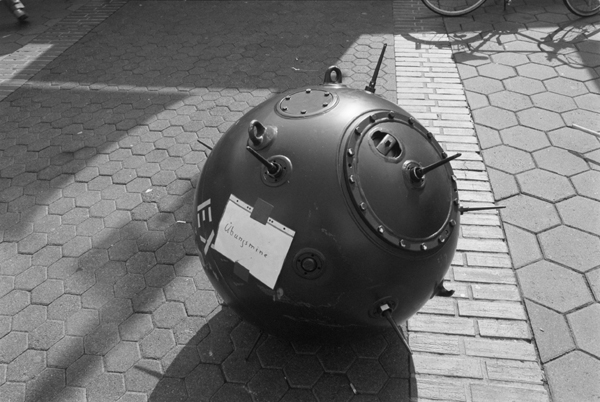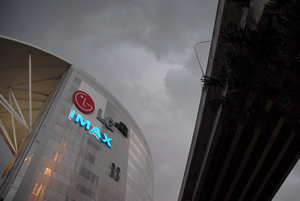The foot print, the pressure of the foot on the ground, walking in mud, on grass, ice, walking on the water.
Edward Tenner’s book intimates how walking itself is, at least partially, a learned social process, with variations introduced by the prosthetic (shoes) and localized environmental responses.
I had observed one aspect of this affect when I moved to Iceland. Icelanders are generally quite healthy — statistically, their longevity is second only to the Japanese. But one formal thing I did notice is the lack of prominent gluteal muscles. Flat arses! The difference was notable, coming the ethnically diverse US, where (aside from rampant morbid obesity) arses are, well, noticeable. In Iceland, they were noticeably absent: flaccid and flat. This puzzled me for some time until winter arrived and ice began to cover everything on a regular basis. Walking with a rolling gait that emphasizes a constant forward propulsion, ending with a final accelerating push off the big toe is fine when on a solid surface with decent traction. Try that on ice (this is Ice Land, right?), and one immediately discovers how, without traction, that ‘normal’ gait destabilizes the balance as the body is expecting acceleration, but not getting it (when it loses traction). The push off with the toe is ineffectual, and when one foot actually leaves the surface, between the lack of acceleration, and a compromised vertical positioning of the body (which was expecting the legs to be more forward), slipping and falling becomes a very real possibility.
Tenner, E., 1997. Why things bite back: technology and the revenge of unintended consequences, New York: Vintage Books.
Understanding this from being aware of my own movements (and instances of compromised balance), and watching locals, I noticed several major differences between their gait and mine. The primary feature of the local walk was that both feet never really left the ground and contact was flat-footed and somewhat stiff-legged. There was a substantial time when the full sole of the shoe was flat on the ice, and it was during that time when forward acceleration was made.
If you try this yourself, you will immediately see that the glutes are not the site of any muscular effort for locomotion as opposed to when accelerating off the big toe and Achilles tendon. Could this be the source of the predominance of flat bums in Iceland?
Aside from the glare-ice technique, there was another endearing and embodied gait by farmers when walking their fields. A thousand years of overgrazing sheep has seriously compromised most of Iceland’s grasslands. As the land was overgrazed, this exposed the underlying volcanic soil directly to powerful eolian erosion which could strip meters away down to a gravelly bedrock surface in no time. When life again attempts to establish itself on that surface, after sheep are removed from the picture, it first starts as minuscule moss colonies which grow in the shelter of a small cobble or so. The moss begins to capture wind-borne soil which gradually increases the colony size which increases the turbulent capture of airborne sediment. Over a period of decades these moss colonies form a hummocky surface with a relief of perhaps 50 cm (18 inches) and a horizontal frequency of a meter or so. To walk across such a surface is absolutely exhausting unless you conform your body in a particular way. The Icelandic farmer’s gait consists of the following: hands clasped behind the back, an exaggerated forward hunch of the upper body, and the knees bent dramatically. Leaning forward, and using the bend in the knees to essentially level out the distance between the upper body and the average ground height of the bottom of the hummocks, one takes long strides where the torso never goes up and down, but rather the level changes of the hummocks are compensated by different extensions of the knees. It’s humorous to watch, but is highly effective and a very rapid gait. If one tries ‘normal’ walking, climbing up and down the hummocks, it is slow and absolutely exhausting.




 The latch handles on both the driver- and passenger-side door are broken. There is a certain geometry on the plastic lever-arm which, over time of repeated lifting motions, fails. So I have to replace them. The truck is relatively old, compared to the average age of vehicles on the road. I call the Toyota dealer nearby, and they want almost USD100 for each replacement handle. This is called an OEM part — Original Equipment Manufactured — a part which carries some of the branded weight of the maker and its record of quality along with a premium price (including a substantial markup to underwrite the existence of the dealer distribution system). Too much! I knew this would be the case before I called, but I wanted to set a ceiling price before looking elsewhere, online. This particular vehicle model was globally a widely-distributed frame, body, and engine combination and so there turns out to be a substantial non-OEM parts market. The only question is one of quality. Non-OEM parts online appear to be both Mainland Chinese- and Taiwanese-made with what seems to be a substantial US distribution presence in the form of highly discounted warehouses designed for online mail-order sales (with Ebay, Amazon, and their own web sales presence). I find the parts, in several styles (chromed plastic and black) for a small fraction of the OEM cost, USD 20 with free shipping.
The latch handles on both the driver- and passenger-side door are broken. There is a certain geometry on the plastic lever-arm which, over time of repeated lifting motions, fails. So I have to replace them. The truck is relatively old, compared to the average age of vehicles on the road. I call the Toyota dealer nearby, and they want almost USD100 for each replacement handle. This is called an OEM part — Original Equipment Manufactured — a part which carries some of the branded weight of the maker and its record of quality along with a premium price (including a substantial markup to underwrite the existence of the dealer distribution system). Too much! I knew this would be the case before I called, but I wanted to set a ceiling price before looking elsewhere, online. This particular vehicle model was globally a widely-distributed frame, body, and engine combination and so there turns out to be a substantial non-OEM parts market. The only question is one of quality. Non-OEM parts online appear to be both Mainland Chinese- and Taiwanese-made with what seems to be a substantial US distribution presence in the form of highly discounted warehouses designed for online mail-order sales (with Ebay, Amazon, and their own web sales presence). I find the parts, in several styles (chromed plastic and black) for a small fraction of the OEM cost, USD 20 with free shipping. 





